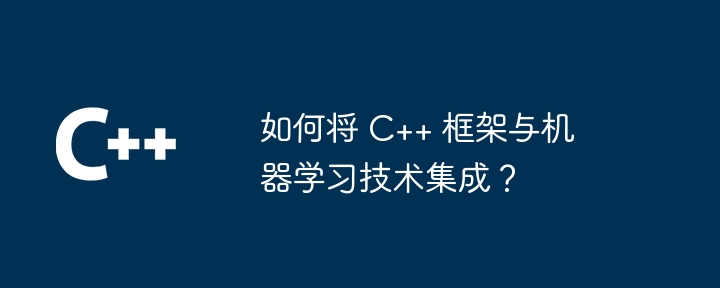集成 c++++ 框架和机器学习技术,以提高应用程序性能和功能:准备数据和模型:收集数据,训练模型并将其保存为 tensorflow lite 格式。集成 tensorflow lite:在 c++ 项目中包含 tensorflow lite 头文件和库。加载模型:从文件加载 tensorflow lite 模型。创建解释器:创建 tensorflow lite 解释器对象。分配输入/输出张量:分配输入和输出张量大小。设置输入数据:复制数据到输入张量中。运行模型:调用 tflite::interpreter::invoke() 函数。获取输出数据:

集成 C++ 框架和机器学习技术可以显着提高应用程序的性能和功能。本文将指导您完成将 TensorFlow Lite 与 C++ 应用程序集成的步骤,并提供一个实战案例。
以下是如何将机器学习模型集成到 C++ 应用程序中的通用步骤:
tflite::FlatBufferModel::BuildFromFile() 从文件加载 TensorFlow Lite 模型。tflite::Interpreter 对象,它将解释和执行模型。tflite::Interpreter::ResizeInputTensor() 和 tflite::Interpreter::ResizeOutputTensor() 分配输入和输出张量的大小。tflite::Interpreter::Invoke() 来运行模型。实战案例:图像分类
立即学习“C++免费学习笔记(深入)”;
下面是一个使用 TensorFlow Lite 进行图像分类的示例应用程序:
#include <opencv2/opencv.hpp>
#include <tflite_runtime/interpreter.h>
int main() {
// 加载图像
cv::Mat image = cv::imread("image.jpg");
// 预处理图像
cv::resize(image, image, cv::Size(224, 224));
// 创建 TensorFlow Lite 解释器
tflite::Interpreter interpreter;
interpreter.BuildFromFile("mobilenet_v2_1.0_224_quant.tflite");
interpreter.AllocateTensors();
// 设置输入张量
interpreter.inputs()[0]->data.uint8 = image.data;
// 运行模型
interpreter.Invoke();
// 获取输出张量
float* output = interpreter.outputs()[0]->data.f;
// 获取预测结果
int predicted_class = std::max_element(output, output + 1000) - output;
// 打印预测结果
std::cout << "Predicted class: " << predicted_class << std::endl;
return 0;
}结论
通过将 TensorFlow Lite 集成到 C++ 应用程序中,开发人员可以无缝地利用机器学习模型来增强其应用程序的功能。遵循本文中概述的步骤,您就可以成功地实施 C++ 和机器学习技术的强大结合。
以上就是如何将 C++ 框架与机器学习技术集成?的详细内容,更多请关注php中文网其它相关文章!

每个人都需要一台速度更快、更稳定的 PC。随着时间的推移,垃圾文件、旧注册表数据和不必要的后台进程会占用资源并降低性能。幸运的是,许多工具可以让 Windows 保持平稳运行。

Copyright 2014-2025 https://www.php.cn/ All Rights Reserved | php.cn | 湘ICP备2023035733号